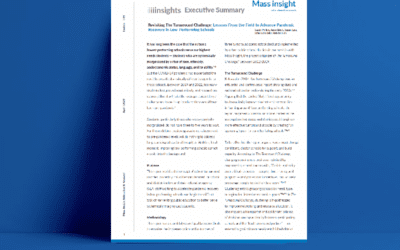The Boulder Fund grant will allow Mass Insight to pilot a new program targeting middle school readiness. May. 22, 2025 –Boston– Mass Insight Education & Research’s President and CEO, Andrea Wolfe, has been selected in the 2025 cohort of Education Leaders of...
Fulfilling the Promise: The Potential of Advanced Placement to Improve College Outcomes for Black, Latino, and Low-Income Students
The U.S. economy requires a highly educated workforce. Ninety nine percent of all new jobs created between January 2010 and January 2016 went to workers with at least some college education, and the U.S. government projects that nearly forty percent of jobs will require at least some college by 2028. Yet deep and persistent racial, ethnic, and socioeconomic disparities in college outcomes threaten the country’s ability to meet its workforce needs.
Key Takeaways from this Insights Paper:
- Introducing diverse students to the rigors of AP and supporting their success is a promising strategy for improving college readiness and success.
- Mass Insight’s AP STEM & English program improves AP participation and performance, particularly among Black, Latino, and low-income students.
- AP STEM & English program participants also outperform students statewide in college matriculation, persistence, and graduation.
- Although the AP STEM & English program was not designed to close racial, ethnic, and socioeconomic gaps in AP participation and performance or college outcomes, program data offer a useful opportunity to evaluate AP’s promise as a high-leverage strategy for closing persistent racial, ethnic, and socioeconomic disparities in college outcomes.
- Analyses suggest that improving AP participation and performance among Black, Latino, and low-income students relative to White mid- to high-income students will narrow but not completely eliminate corresponding disparities in college outcomes.
- To maximize the gap-closing potential of AP interventions, practitioners may wish to consider explicitly targeting additional supports to Black, Latino, and low-income students or embedding AP into more holistic college readiness interventions.
Download the Resource
The Potential of Advanced Placement to Improve College Outcomes for Black, Latino, and Low-Income Students

Recent Posts
Cybersecurity Event Introduces Students to Cyber Careers
For the 5th year in a row, Mass Insight Education & Research is hosting the Cybersecurity and You Workshop to introduce Advanced Placement® (AP) STEM high school students to cybersecurity scenarios and concepts as well as postsecondary education and career paths....
Adolescent Literacy Crisis: IES Guide In Action – Webinar
What does the evidence say about how schools can improve the adolescent literacy crisis happening in our country? In this webinar, we explore the Institute of Education Sciences Reading Intervention Guide for Grades 4 through 9, found here, and diving into two of the...
You may also like
All Over The Map: Massachusetts High School Graduation Requirements
A new report by the Voices for Academic Equity Coalition, of which Mass Insight is a founding member, unpacks the status of the state’s MassCore curriculum, a recommended opt-in course of study for the state’s high school students. Massachusetts currently has just...
Executive Summary: Revisiting The Turnaround Challenge
Our report, Revisiting The Turnaround Challenge: Lessons From the Field to Advance Pandemic Recovery in Low-Performing Schools, takes a look back at the Zone model presented in our seminal 2007 report, The Turnaround Challenge, and uses three anonymous district case...
Revisiting The Turnaround Challenge: Lessons From the Field to Advance Pandemic Recovery in Low-Performing Schools
It has long been the case that the nation’s lowest performing schools serve our highest needs students — students who are systemically marginalized by virtue of race, ethnicity, socioeconomic status, language, and/or ability. But the COVID-19 pandemic has exacerbated...


